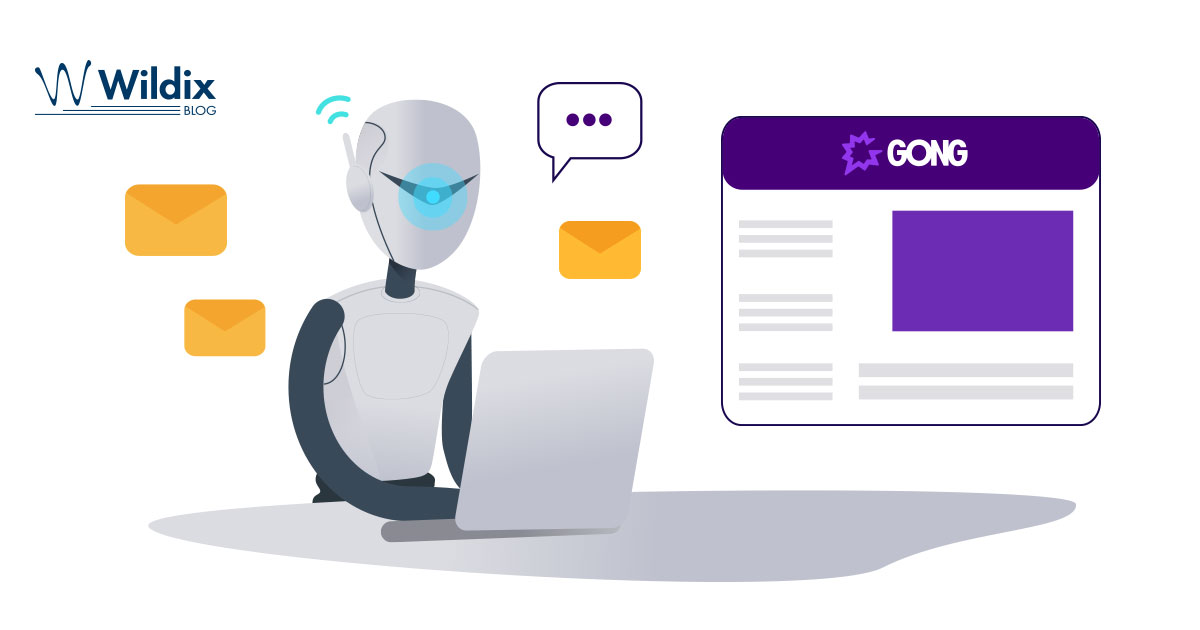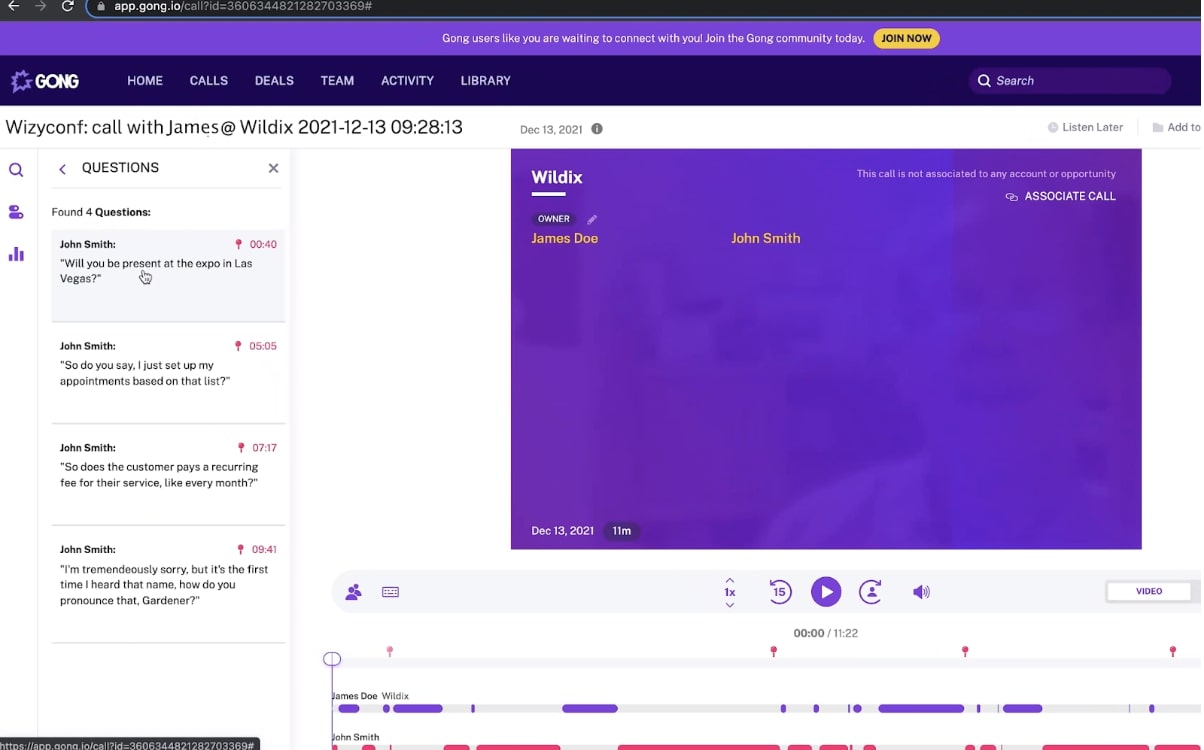
Automation is about a lot more than making everyday work easier. As we’ve discussed in our last posts, automating procedures can bring enormous benefits to the entire sales funnel — all the more so when implemented strategically. More than just eliminating the busywork of one given task, the advantages ripple out through your entire workflow.
With all that talk about automating in the abstract, at this stage it’s time to talk about using automation with a very real setup: combining the Wildix system with the state-of-the-art business intelligence tool Gong.
Let’s see this actual case of process automation and how it brings significant advantages to your entire sales funnel.
What Is Gong?
Before we get started, we should clarify what the Gong solution is.
Gong is an AI-powered business intelligence tool that takes the guesswork out of sales. At its simplest, Gong is a kind of data analytics solution: feed it the input of real sales communication data, and it offers the output of call summaries, sales insight and analytics.
As a speech analysis and transcription tool, Gong also can differentiate between speakers and languages. So long as it’s hearing your team talk, Gong can provide significant insight into the conversation. That insight only improves as you continue using it, too, because the solution’s machine learning means its analytical abilities get better and better the more data it has to chew over.

Of course, where Gong really shines is as part of a larger flow of processes, which is exactly why Wildix integrated the solution into the x-bees communication system. And that combination is tailor-made to smooth over the specific workflow behind landing sales.
Gong & Wildix in Action
So, how does Gong work alongside the Wildix system?
For starters, like any good automation tool, Gong works pretty much invisibly within the Wildix solution. At its simplest, the tool simply plugs into the x-bees communication system and does its thing silently and out of sight. Once you need greater insight, that analysis is automatically transferred over to your CRM of choice for use at your leisure.
But let’s break down the steps of how this integration works a bit more cleanly.
Step 1: Placing a Sales Call
Gong kicks in as soon as a sales representative places a call to a sales prospect or when they receive a call from a prospect. Thanks to the integration with x-bees, Gong activates automatically, so the representative doesn’t have to remember to turn on the solution or any of its capabilities.
While the call is occurring, Gong simultaneously records and transcribes the conversation — and, as we said, distinguishes between the sales agent and the prospect the whole time. This is noteworthy because Gong tracks specific phrases from the prospect, in particular objections, hesitations and mentions of competitors.
Of course, it’s also keeping track of everything the sales representative is saying. The tool will make particular note of how the agent responds to those hesitations, then use its knowledge base to determine how effective of a response it is.
By the end of the call, Gong will have prepared both an audio recording and a written transcript. But of course, it will have a lot more to provide as well: for one thing, it will have already added key contact information from the customer to your CRM, removing the tedious work of manual data entry.
Step 2: Going Over the Call
As we said, Gong analyzes content from communications in real-time, right as the call happens. A big benefit to this is sales agents no longer have to take notes during the call because it’s all being written down automatically — but, like any effective automation tool, Gong does more than simplify one step in the sales funnel.
After the call, Gong will automatically transfer the data it’s collected to your CRM of choice. There, you can easily see the main points from the call as selected by Gong: objections, discovery questions, quantities, questions and so on. Rather than have to read through the call in its entirety, you can instead go through the main points of the call to determine the prospect’s attitude and any next steps.
Note that this analysis also extends to the sales representative’s side of the conversation. The data highlights here will also include questions asked by the agent, statistics on how much the agent let the prospect talk and analytics on how often the agent used phrases proven to advance a deal.
Thanks to this breakdown, Gong establishes a prediction of what needs to happen next for the deal to land — in particular, what needs to change in the prospect’s mind and what the sales agent needs to do in order to make that change.
Step 3: Completing the Deal
After taking in these points, sales agents use their own skills and get it done: they bring the deal to a close.
Although this marks the end of the workflow process, it’s not the end of working with Gong. The outcome of this particular sale and the data surrounding it can provide helpful training to other sales agents, showing them what works in a sales conversation and what doesn’t.
But perhaps just as importantly, all this information is added to your sales directory automatically, eliminating the usual busywork of inputting data manually. Like any effective automation tool, Gong makes gathering relevant data fast, seamless and entirely uncomplicated — all without having to spend hours of work on the project.
Wildix Ties It All Together
To make all this work effectively, however, you need a robust communications system running these sales calls. We’ve said before that a CRM needs unified communication integration to work at its best, and that’s also true for automating the workflows related to making sales calls. After all, flexibility and worthwhile integrations are key to kickstarting automation, for the simple reason that any software you want to automate should be open to that configuration.
Case in point, the above procedures are available as described in x-bees, the sales communications solution from Wildix. Because x-bees is designed from the ground up to work with Gong, it provides the full benefits of an automated work process right away. Naturally, that’s on top of the capabilities x-bees has on offer just on its own.
As much difficulty as enabling process automation often imposes, with the right system on hand, those procedures can be introduced quickly or even immediately upon installation.
See even more detail about Wildix and Gong with our video demonstration:
Automation, in Conclusion
At its best, automation doesn’t so much replace human efforts as it enhances them. Menial tasks like note-taking, data entry and raw data analysis are ready choices for automation not simply because they usually take little thought to carry out. More importantly, by automating these procedures, a business gives employees more time and energy to devote to the parts of their job that require more delicate and deliberate care.
In the context of landing sales and closing deals, the biggest advantages people can put forward are talking to prospects and formulating communication strategies. Any effort machines put toward sales, therefore, needs to be in support of those main activities.
The setup provided by Gong and Wildix checks all the proper boxes for automation because it works toward that specific support. From beginning to end, the automation provided here is in service of talking to prospects and deciding on better ways to advance that conversation. It doesn’t seek to actively replace efforts from sales agents, because that’s not what will best enhance a sales team; rather, the setup redirects sales efforts solely toward productive work that requires their specific talents.
That simple philosophy is how Wildix and Gong work for a more effective, more user-oriented workflow in all steps of your sales funnel.
For more tips on using technology to improve work procedures, subscribe to receive our magazine for free!